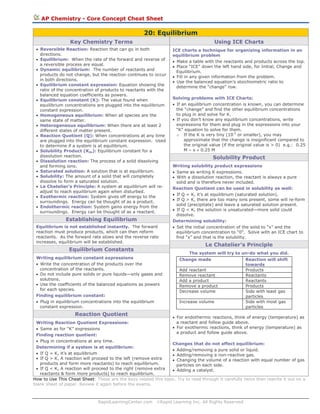Contenu connexe
Similaire à Equilibrium cheat sheet
Similaire à Equilibrium cheat sheet (20)
Plus de Timothy Welsh (20)
Equilibrium cheat sheet
- 1. AP Chemistry - Core Concept Cheat Sheet
20: Equilibrium
Key Chemistry Terms
Using ICE Charts
• Reversible Reaction: Reaction that can go in both
directions.
• Equilibrium: When the rate of the forward and reverse of
a reversible process are equal.
• Dynamic equilibrium: The number of reactants and
products do not change, but the reaction continues to occur
in both directions.
• Equilibrium constant expression: Equation showing the
ratio of the concentration of products to reactants with the
balanced equation coefficients as powers.
• Equilibrium constant (K): The value found when
equilibrium concentrations are plugged into the equilibrium
constant expression.
• Homogeneous equilibrium: When all species are the
same state of matter.
• Heterogeneous equilibrium: When there are at least 2
different states of matter present.
• Reaction Quotient (Q): When concentrations at any time
are plugged into the equilibrium constant expression. Used
to determine if a system is at equilibrium.
• Solubility Product (Ksp): Equilibrium constant for a
dissolution reaction.
• Dissolution reaction: The process of a solid dissolving
and forming ions.
• Saturated solution: A solution that is at equilibrium.
• Solubility: The amount of a solid that will completely
dissolve to form a saturated solution.
• Le Chatelier’s Principle: A system at equilibrium will readjust to reach equilibrium again when disturbed.
• Exothermic reaction: System gives off energy to the
surroundings. Energy can be thought of as a product.
• Endothermic reaction: System gains energy from the
surroundings. Energy can be thought of as a reactant.
ICE charts a technique for organizing information in an
equilibrium problem
• Make a table with the reactants and products across the top.
• Place “ICE” down the left hand side, for Initial, Change and
Equilibrium.
• Fill in any given information from the problem.
• Use the balanced equation’s stoichiometric ratio to
determine the “change” row.
Establishing Equilibrium
Equilibrium is not established instantly. The forward
reaction must produce products, which can then reform
reactants. As the forward rate slows and the reverse rate
increases, equilibrium will be established.
Equilibrium Constants
Writing equilibrium constant expressions
• Write the concentration of the products over the
concentration of the reactants.
• Do not include pure solids or pure liquids—only gases and
solutions.
• Use the coefficients of the balanced equations as powers
for each species.
Finding equilibrium constant:
• Plug in equilibrium concentrations into the equilibrium
constant expression.
Solving problems with ICE Charts:
• If an equilibrium concentration is known, you can determine
the “change” and find the other equilibrium concentrations
to plug in and solve for K.
• If you don’t know any equilibrium concentrations, write
expressions for them and plug in the expressions into your
“K” equation to solve for them.
o If the K is very tiny (10-5 or smaller), you may
approximate that the change is insignificant compared to
the original value (if the original value is > 0) e.g.: 0.25
M – x ≈ 0.25 M
Solubility Product
Writing solubility product expressions
• Same as writing K expressions.
• With a dissolution reaction, the reactant is always a pure
solid and is therefore never included.
Reaction Quotient can be used in solubility as well:
• If Q = K, it’s at equilibrium (saturated solution).
• If Q > K, there are too many ions present, some will re-form
solid (precipitate) and leave a saturated solution present.
• If Q < K, the solution is unsaturated—more solid could
dissolve.
Determining solubility:
• Set the initial concentration of the solid to “x” and the
equilibrium concentration to “0”. Solve with an ICE chart to
find “x” and that is the solubility.
Le Chatelier’s Principle
The system will try to un-do what you did.
Change made
Add reactant
Remove reactant
Add a product
Remove a product
Decrease volume
Increase volume
Reaction Quotient
Reaction will shift
towards
Products
Reactants
Reactants
Products
Side with least gas
particles
Side with most gas
particles
• For endothermic reactions, think of energy (temperature) as
a reactant and follow guide above.
Writing Reaction Quotient Expressions:
• For exothermic reactions, think of energy (temperature) as
• Same as for “K” expressions
a product and follow guide above.
Finding reaction quotient:
• Plug in concentrations at any time.
Changes that do not affect equilibrium:
Determining if a system is at equilibrium:
• Adding/removing a pure solid or liquid.
• If Q = K, it’s at equilibrium
• Adding/removing a non-reactive gas.
• If Q > K, A reaction will proceed to the left (remove extra
• Changing the volume of a reaction with equal number of gas
products and form more reactants) to reach equilibrium.
particles on each side.
• If Q < K, A reaction will proceed to the right (remove extra
• Adding a catalyst.
reactants & form more products) to reach equilibrium.
How to Use This Cheat Sheet: These are the keys related this topic. Try to read through it carefully twice then rewrite it out on a
blank sheet of paper. Review it again before the exams.
RapidLearningCenter.com
©Rapid Learning Inc. All Rights Reserved

